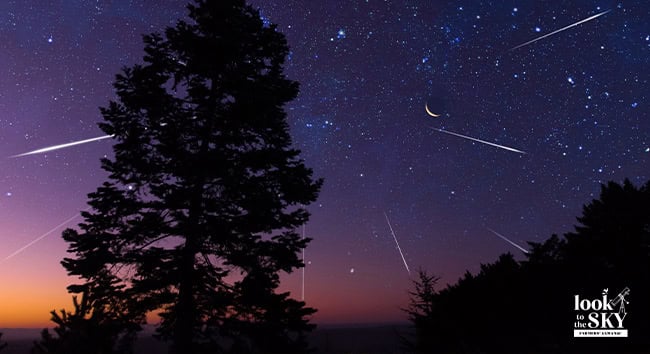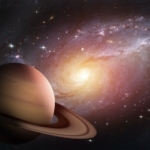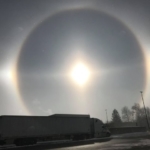January night sky highlights include one of the best meteor showers of the year, an opportunity to see how the Moon moves in its orbit, many recognizable stars, and the Full Wolf Moon. Plan your stargazing activities with this helpful calendar of sky events. Have questions? Ask us in the comments section below!
Share your love of stargazing with your family and friends this year! Don’t miss our growing Starry Nights Gift Guide—gifts for night sky lovers of every age and stage!
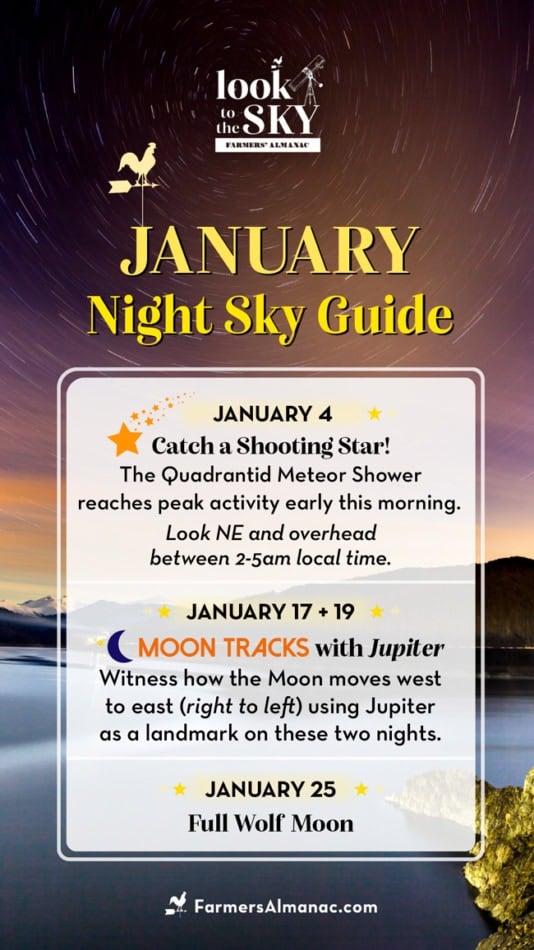
January Night Sky 2024
All times and positions are listed in Eastern time, 40 degrees north of the equator—unless otherwise listed. If you see the term “local time,” it is true no matter where you are located (no need to add or subtract for your time zone).
January 2 – Earth At Perihelion
At 7:39 p.m. EST, Earth is at its closest point to the Sun, a position called “perihelion,” with a distance of 91,404,095 miles. You might be puzzled, asking yourself why it’s winter in the Northern Hemisphere when we’re so close to the Sun. The answer is pretty simple: it’s not about how close we are to the Sun, but how our Earth is tilted. During this period, the Northern Hemisphere is leaning away from the Sun, which means we get less sunlight. And less sunlight means it’s going to be colder.
RELATED: Learn more about perihelion and aphelion
January 3 – Last Quarter Moon
The last quarter Moon occurs at 10:30 p.m. EST.
RELATED: Moon Phase Calendar
⭐ January 4 – Catch A Shooting Star In The January Night Sky!
The Quadrantid Meteor Shower is a dazzling annual event. This year, it’s going to reach peak activity early this morning, at around 4 a.m. EST. Look northeast and overhead between 2-5 a.m. to catch a shooting star or three. Sometimes, this shower gives a spectacular show with 40 to 200 shooting stars every hour.
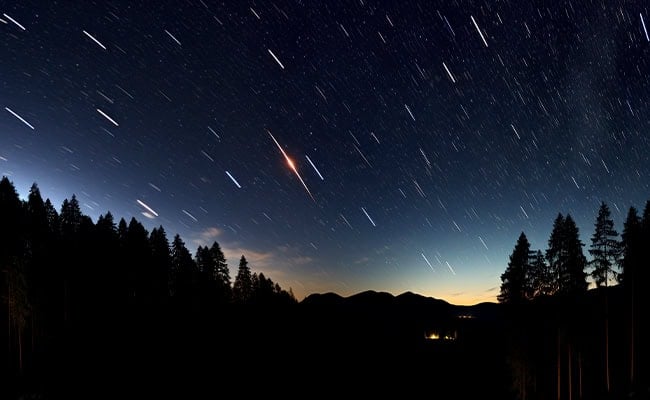
Unfortunately, this year’s display may be spoiled by the bright Moon. The last quarter Moon will rise after midnight, which is around the same time the meteor shower becomes visible in the northeast sky. (The point in the sky where the meteors seem to come from, called the radiant, is in a part of the sky that used to be called the Quadrans Muralis constellation. It’s found about halfway between the head of the Draco constellation and the end of the Big Dipper’s handle.)
Because of the Moon, there may be fewer meteors visible this year. You might be able to see about 12 to 24 meteors per hour before the break of dawn.
One thing to remember is that there might be a few meteors visible up to a week before and after the peak date. It’s also worth noting that the meteors you see during and after the peak tend to be brighter than those you see before.
January 8 – Venus And The Crescent Moon
To catch a glimpse of the stunning planet Venus and a thin crescent Moon (which will be 11% lit), look towards the southeast just around 6 a.m. local time. You might also spot Antares, a bright red star beneath the Moon. And if you look down and to the left of Venus, you’ll be able to see another planet, Mercury.
Up for a challenge? If you live in the western United States, you will have an opportunity to watch as the crescent Moon passes in front of Antares for a short while, a phenomenon known as an occultation.
The best locations to watch this stellar eclipse is along the West Coast, where Antares disappears very low near the east-southeast horizon before the break of dawn and will reappear from behind the Moon’s dark edge just as the sky begins to brighten.
For those in the Midwest, the bright crescent covers Antares around sunrise. Slightly farther west, in the Mountain Time Zone, the star goes behind the Moon during dawn twilight. With a telescope from this part of the country, the star will reappear from behind the dark Moon’s side about 30 to 45 minutes after sunrise, but only if the sky is exceptionally clear and free of haze.
Unfortunately, across the eastern half of the country, this game of “celestial hide-and-seek” all takes place well after sunrise.
RELATED: Total Solar Eclipse 2024
January 11 – New Moon
The new Moon occurs at 6:37 a.m. EST.
January 12 – Mercury
Mercury, a bright planet at this time of year, will be at its furthest point west of the Sun, making it more visible from Earth. This event is often called “greatest elongation.” Throughout most of January, when the Sun rises quite late, Mercury will be located quite far to the lower left of Venus. From January 11-26, these two planets will be relatively close, within about twelve degrees of each other.
On the day of this greatest elongation, Mercury will rise almost two hours before the Sun. This means it’s well above the horizon and easily visible about an hour before the Sun comes up. By the start of February, Mercury will rise much closer to sunrise, about 45 minutes before. But don’t worry, it will still shine brightly in the sky.
January 13-19 – Orion Constellation In The January Night Sky
Look to the southern sky around 10 p.m. this week to see the brightest constellation, Orion: The Hunter.

Orion is home to two massive stars called Rigel and Betelgeuse. Rigel is a blue star and it’s one of the brightest and hottest stars that we know of. It’s in the peak of its life cycle as a star. To give you an idea of how bright Rigel is, it can be anywhere from 61,500 to 363,000 times brighter than our Sun. It’s also pretty far away—about 860 light years. And it’s estimated to be seven to nine million years old.
On the other hand, Betelgeuse, a bright red star, is nearing the end of its life. It’s a bit closer than Rigel, located about 550 light-years away. Unlike Rigel, its light doesn’t shine steadily. Instead, it’s a “pulsating” star, meaning its size changes—sometimes it expands, sometimes it contracts.
RELATED: Is Betelgeuse Ready To Explode?
If we were to replace our Sun with Betelgeuse, there would be times when it would reach beyond Jupiter’s orbit, but not quite touch Saturn’s at nearly 800 million miles. That would mean Betelgeuse could reach a maximum diameter of a staggering 1.6 billion miles! To put it into perspective, a lecturer at New York’s Hayden Planetarium once described Betelgeuse as “an old man with his strength almost entirely spent, panting in the asthmatic decrepitude of old age.”
January 14 – Saturn And The Crescent Moon
Saturn appears as its dependable old self, glimmering into view alone in the southwest sky in Aquarius as dusk fades. This evening, you’ll also see a slender crescent Moon positioned well to Saturn’s upper left.
January 17 – First Quarter Moon
The first quarter Moon occurs at 10:53 p.m. EST.
⭐ January 17+19 – “Moon Tracks” With Jupiter
Jupiter and the Moon make an eye-catching pair in the night sky over these few nights.
Did you know that the Moon moves right to left (west to east) over the course of the month? (This is the opposite direction that it appears to move on any given night.) Get a glimpse of the Moon’s motion as it orbits the Earth by using Jupiter as a landmark on these two nights!
Jupiter moves slower than the Moon, so it makes a great reference point. On January 17, the first quarter Moon will be positioned to the lower right of Jupiter. Two days later, on January 19, the Moon will be positioned to the upper left.
Note: If it is cloudy or foggy on either of these two nights where you are, rest assured there will be many more chances to track the Moon in the future. Stick with us!
⭐ January 25 – Full Wolf Moon
The Full Wolf Moon reaches peak illumination at 12:54 p.m. EST.
The first Full Moon of 2024 is often called the Wolf Moon. This name comes from how wolves are usually more active at the start of the year. The Wolf Moon name has roots in ancient Celtic and Old English traditions, and it was brought to North America by European settlers.
RELATED: Learn More About The Wolf Moon
Some Native American cultures call it the “Sun Has No Strength To Thaw Moon” and “Moon When Snow Drifts Into Tipis.” In Celtic culture, it is known as the “Stay Home Moon.”
RELATED: Full Moon Calendar
January 27 – Mercury And Mars
For the first time since this past summer, you will have a chance to see Mars. Look low on the east-southest horizon about 45 minutes before sunrise. You will see Mercury and situated close below it will be Mars (much fainter). While you may be able to see Mercury with your naked eye, you’ll likely need binoculars to pick out Mars against the brightening sky.
Footnote
Take note that we sometimes will use angular degrees to define the separation between two objects, such as (for example) a bright planet and the Moon. Keep in mind that the width of your clenched fist, held at arm’s length, measures roughly degrees. See this “handy” illustration.
When we speak of magnitude, we are referring to the brightness of an object; the lower the figure of magnitude, the brighter the object. The brightest stars are zero and first magnitude. Under a dark, clear sky, the faintest objects that you can see with just your eyes are fifth or sixth magnitude. Objects with negative magnitudes are the brightest. Sirius, the brightest star, is -1.4. Venus can get as bright as -4.8. A Full Moon is -12.7 and the Sun is a blindingly bright -26.7.
Join The Discussion
Which January night sky event are you looking forward to most?
We would love to hear from you!
Check back for February Night Sky Guide … coming soon.
Have questions? Leave a comment below.

Joe Rao
Joe Rao is an esteemed astronomer who writes for Space.com, Sky & Telescope, and Natural History Magazine. Mr. Rao is a regular contributor to the Farmers' Almanacand serves as an associate lecturer for the Hayden Planetarium in New York City.

